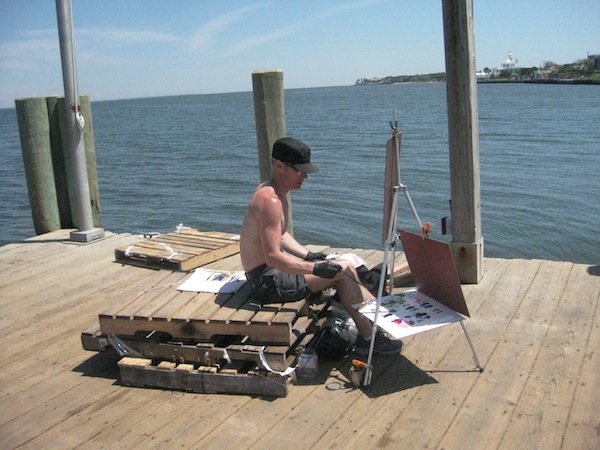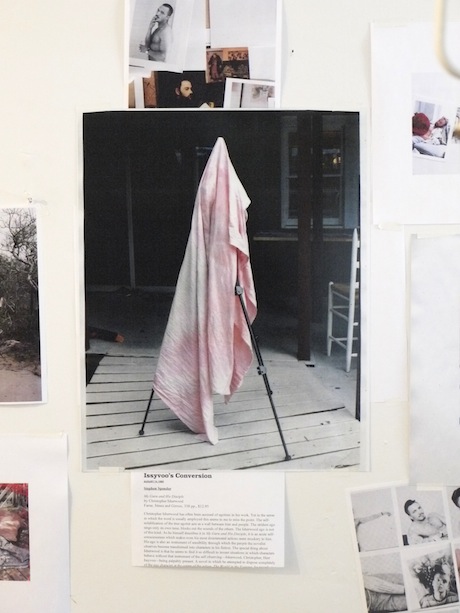“The truth of the matter is that there is no one way to tackle queerness, and there is no one way to tackle queer art making,” Evan Garza, co-director of the Fire Island Artist Residency (FIAR), told me during my visit to the residency last week. Now in its third year, FIAR is the only artist residency in the country dedicated exclusively to queer, emerging artists. FIAR co-director Chris Bogia followed Garza’s sentiment, stating, “I always know that there is going to be some nugget of queerness in anything the residents do. The fun thing is seeing how it operates differently.”
In three years, the program’s already established itself as one to watch; young alumni tend to make waves in the art world (in the last year alone, FIAR 2011 alum A.K. Burns’ collaborative video work was acquired by MoMA and FIAR 2012 alum Gordon Hall presented the Center for Experimental Lectures at MoMA PS1). This is in part because it’s highly selective; this year’s five artists-in-residence were chosen from nearly 300 applicants by jurors Mickalene Thomas and Jack Pierson. A critique of FIAR has been the lack of a female presence, yet this gender disparity is more a reflection of the demographics of applicants to the program than an insensitivity to queer diversity; the overwhelming number of applications come from male-identified artists. In fact, this year more transgender-identified artists applied than lesbian-identified women (the application has an extensive dropdown list of gender and sexual identifications).
Garza and Bogia’s consideration of queer diversity in both artwork and identity was readily apparent in the stark contrast between the 2012 and 2013 programs. In a general sense, last year’s performance– charcoal/lube séance rituals and cruising considerations– gave way this year to object-making– suggestive portraits/photographs and queered abstraction.
While less performance meant that FIAR artworks and interventions may not have been as visible in and around Fire Island’s Cherry Grove, Pines, and Meat Rack settings, FIAR provides an example of a residency deeply invested in giving back to its surrounding community, a model many similar residencies would do well to simulate. During our annual chat, Garza and Bogia emphasized that mission, measuring success in part by increasingly popular public programming. On a given night, the artists-in-residence and locals gathered together at the Cherry Grove Community House to hear artist Hunter Reynolds discuss his work during the height of the AIDS crisis, or to see a Dirty Looks double feature screening of Rosa Von Praunheim’s films.
During my visit to FIAR, I spoke with each of the artists about the work they had conceived over the course of the month-long residency and their creative process in the Fire Island setting. While FIAR’s studio spaces feel quite cramped (a symptom of expensive real estate), the work was strong, with filmmaker Chris E. Vargas and photographer Paul Mgapi Sepuya as standouts. While both Vargas and Sepuya are still emerging artists —as per FIAR’s mission— their work felt the most fully formed. What follows are some highlights from my studio visits.
Chris E. Vargas (Oakland)
Hanging prominently above Chris E Vargas’s studio desk was a poster-sized broadside collage featuring 278 genderqueer figures. These range from the artist Wu Tsang to bureaucrat J. Edgar Hoover, track star Caster Semenya to nightlife starlet Amanda Lepore; all photoshopped into a strength-in-numbers gathering that augments trans visibility. The collage is a good entry point to Filmmaker and Organizer Chris E. Vargas’ work, which during FIAR focused on developing his Museum of TrΔnsgender Hirstory & Δrt (MOTHA). After all, the organization’s mission is in part, “honoring the hiroes and transcestors who have come before.”
MOTHA cheekily inaugurated itself with a ribbon-cutting ceremony this past June, though it’s still a roaming platform. Vargas’s recent open letter introducing the as-of-yet unrealized museum acknowledges both the possibilities and pitfalls of the institutionalization of identity; its figures and graphs are abstractions, but ultimately point to a lack of representation for transgender and genderqueer figures. Aiming to rectify this imbalance, MOTHA’s recent programming, including a panel discussion on the Hollywood “Temporary Transvestite” subgenre (think Mrs. Doubtfire or White Chicks), provides an incisive centering of the transgender community. Conceived of as the first project of its kind, MOTHA aims to catalogue and preserve the far-reaching yet underknown transgender contributions to art and culture, an essential mission for the progression of queer politics.
Paul Mpagi Sepuya (Brooklyn)
Stacks of photographs—both taken on Fire Island and previously—filled Paul Mpagi Sepuya’s tabletop, where he was making an approximately 125-page artist book. The pages bear the marks of his edits, erasures, and everyday actions.
Many of Sepuya’s best images have a self-reflexive quality where the photograph consists of his previous prints and image print-outs hung alongside or laying upon other accumulated material from Sepuya’s studio. These layered images stand out because as composites they show both an initial photograph and the way the printed object, whether displayed on a wall or laying on a surface, exists in the world. While in Sepuya’s makeshift studio, with his work lining the walls and amassed on the table, I got the sense that any number of new Sepuya images could be made simply from photographing this space of accumulation.
Sepuya’s subtle, sensuous images of his inner circle and surroundings reflect a New York-centered milieu of influences and associations; any New Yorker on the gallery and queer beat is likely to recognize one or two of the sitters. They, like Sepuya, are part of the scene. Sepuya’s handmade artist book object blurs the lines of autobiography and fiction by pairing his photographic print-outs with the words and images of others from scanned texts and rephotographed book pages. Sepuya plans on showcasing the bound singular book object alongside a handful of archival prints at the NY Art Book Fair at MoMA PS1 in September; as a fascinating document of his sitters over time, I recommend spending at least 10 minutes at Sepuya’s booth this fall to flip through it yourself.
Laurel Sparks (Brooklyn)
Sparks’ abstract paintings stem from sources as diverse as the symbols of occult mysticism, queer coding, and the shape of letters. Her typically large-scale practice (many of Sparks’s paintings are over 4 feet tall) felt limited by the small FIAR studio space, but she made do by producing five 23” x 23” abstract paintings based on the dimensions of Brion Gysin’s magical squares.
Sparks spoke about her abstractions as more than paintings; to her, they are conjured talismans or relics that take on additional layers of meaning through the accumulated material of her alchemical process. With her FIAR works, Sparks invoked a ritual in the creation of each painting that involved pouring water and incorporating sand from the Fire Island beach onto these canvases. A painting such as “Lionheart” also contains a diverse range of queer signifiers and tactile qualities, with its perforated canvas holes, glitter and sand as material excess, and symbolic pink triangle. At first look, Sparks’ abstractions appear rather haphazard and difficult to decipher, but her explanation of process ultimately makes the paintings worthwhile through their queer craft in making.
Grey Dey (San Francisco)
In contrast to Sparks’ painting practice, Grey Dey (see at top) made some of the more composed work of FIAR. Dey primarily paints portraits with erotic undertones from en plein air poses, and made preliminary work on six oil paintings of Fire Island community members during the residency. Dey painted his sitters on-site, requiring at minimum three hours in a steady pose, before returning to his exterior porch studio space to finish the oil paintings from photographs. His work expanded during FIAR from lone models to additional portraits of dual sitters, including a painting of Bill Arning —one of the residency’s visiting lecturers and the Director of the Contemporary Arts Museum in Houston— and his partner Mark. Dey’s stated interest in the “visual projection of identity” seems a bit at odds with the interiority of his portraits’ sitters; most gaze askance past the viewer, and Dey most often renders their faces in shadow. Though he has been making oil paintings since the early 2000s, he spoke most excitedly about being inspired by the FIAR visiting artist lecture from Hunter Reynolds to perhaps return to the performative and conceptual activist practice he was producing in rural Vermont during the height of the AIDS crisis. While still only a brainstorm at this point, Dey’s anecdote speaks to the influence that many of the visiting artist lectures and studio visits had on the residents.
Baker Overstreet (New York City)
Overstreet’s studio was a carnivalesque workshop of felt, yarn, and miscellaneous debris, much of which he is using to incorporate puppetry into his practice for the first time. Overstreet spent his FIAR experience experimenting with sculptural puppets for a potential puppet show inspired by his cabaret/drag showbiz persona June Fagley (music drifting from Overstreet’s studio throughout the day consisted of a combination of showtunes and merry-go-round revelry). Overstreet describes Fagley’s over-the-top act as a “bad clown trunkshow” and envisions her as the puppeteer of the production; Fagley’s theatrical influence can be felt in the Judy Garland-esque quality and charisma of the puppets themselves. In contrast, Overstreet’s more developed practice consists of bright, totem-esque paintings with the architectural forms of theatrical marques; he’ll incorporate these into the puppetry performances by painting similar proscenium backdrop sets. Though the puppet show’s narrative is still in the works, with this project Overstreet is aiming to bring together the previously disparate performance and painting elements of his work. Like the rest, Overstreet’s stretching his practice, and FIAR is proving to be a testing ground fostering the next generation of queer artists.







Comments on this entry are closed.